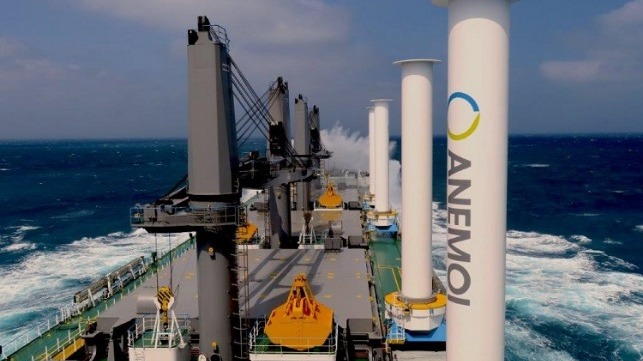A Fresh Wind is Blowing Through Shipping’s Decarbonization Challenge

No one has a crystal ball, and predictions about future pathways and fuel options in shipping are inherently difficult, but there is general agreement in the industry that we are in a period of major transition with great uncertainty and a significant pressure to decarbonize our operations. The IMO initial strategy in April 2018 called for at least 50 percent reduction in CO2 emissions by 2050 and the gauntlet has been laid down by Maersk with their announcement at the end of last year that their fleet will be carbon neutral by the same date.
What is required to achieve that goal and who is going to deliver on that? One increasingly attractive option that provides some predictability and future proofing for vessels is the adoption of direct wind propulsion:
“We all face the immense challenge of rapidly decarbonizing shipping and technology that can deliver 5-20 percent, possibly 30 percent fuel savings as retrofit options and 30 percent upwards for new optimized vessels can’t be ignored – the issue is not why, but when and how we will install wind solutions.” said Gavin Allwright, Secretary of the International Windship Association (IWSA) at the GREEN4SEA award ceremony at the Yacht Club of Greece when receiving the prestigious Initiate Award on Tuesday March 12.
IWSA will be bringing the message that modern, automated wind-assist and primary wind propulsion solutions are a credible, viable and increasingly economically attractive package of solutions to Canada and the US in the next couple of weeks. Holding a series of open, free to attend seminars at the Port of Vancouver (March 27), an NGO seminar in Washington DC (April 1) and at the San Francisco Boat show on (April 5). Allwright will also be on shipping decarbonization panels at CMA 2019 and Seatrade Global Cruise in Miami
“The of use of wind propulsion technology is a growing trend in the industry with installations of Flettner rotors increasing strongly over the last 12 months, with six vessels and 14 rotors installed,” adds Allwright, “however other developments with rigid sail, suction wings, kites and more traditional soft sail are also moving up a gear. Recent entrants into the sphere of wind propulsion include; Maersk, Airbus, Renault group, Viking Lines, Chantiers de l’Atlantique, Drax, MOL and others, so the question is not why should we adopt direct wind propulsion but when and how?”
This diverse support for wind propulsion is also on show on this Canada and US tour, supported by IWSA members Anemoi Marine Technologies, Dasivedo Design, eConowind, Inerjy, MARIN, Neoline, Norsepower, Oceanfoil, Peace Boat – Ecoship Project, Sail Cargo Inc., Smart Green Shipping Alliance, Wind + Wing Technologies and also backed by key U.S. and Canada based organizations; Green Marine, NAMEPA and the leading shipping conference organizers SHIPPINGInsight.
As the industry moves past the sulfur cap compliance issues at the end of this year, all heads will be turned to decarbonization and CO2 emissions. The winds of change are clear to see and one certainty in the market is that wind propulsion technologies are here to stay.
The products and services herein described in this press release are not endorsed by The Maritime Executive.
